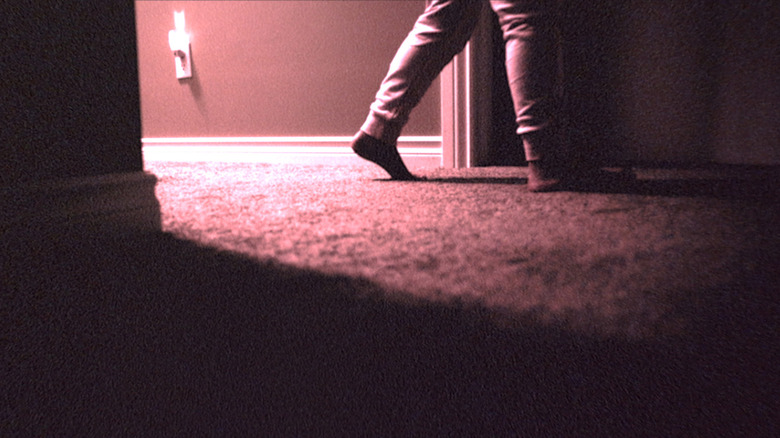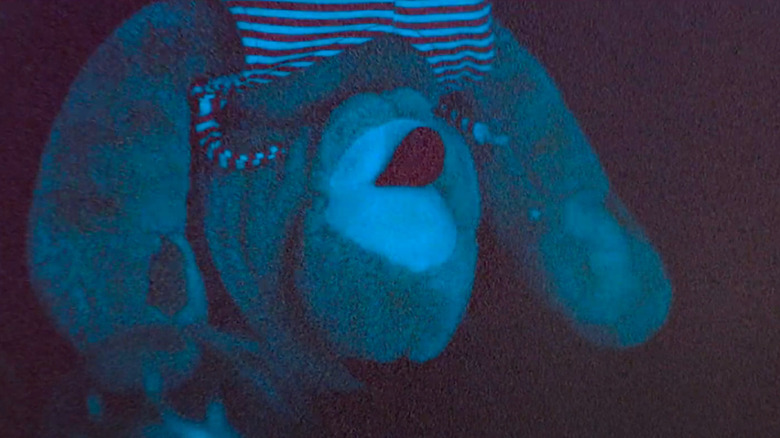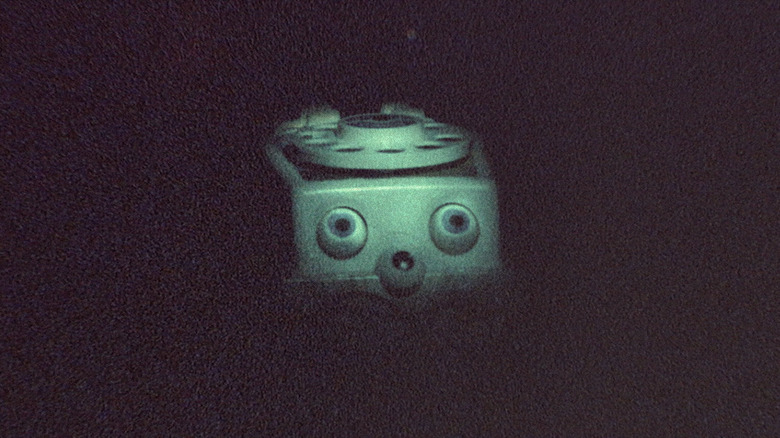
This post contains spoilers for "Skinamarink."
The horror genre has had its fair share of creepy kid stories over the years, and we've even seen a resurgence of this trope in some recent hits. Children anywhere from ages 8 to 13 are excellent protagonists for the kind of survivalist stories horror creates because their brains can comprehend the situation and react to it, maybe not entirely like adults but close enough that they actually have a chance. But with newcomer Kyle Edward Ball's horror masterpiece, "Skinamarink," the deck is not stacked as fairly. The small yet pivotal casting choice of making a preschooler your protagonist isn't an easy one — but it is one that will undoubtedly ramp up the terror. Not only does this choice serve to frighten us even further, but it also shapes the entire film's emotional core. In fact, "Skinamarink" works best when you become emotionally invested in the unfathomable plight of a 4-year-old.
The harrowing exploration of a nightmare scenario, in which 4-year-old Kevin's parents and sister disappear in a home whose doors and windows have also vanished, is rendered entirely new by the fact that our lead character is a very young child. Upending the playing field like that can be looked at as cruel — and in this film, it certainly is — which is why most writers don't opt to build stories around preschoolers or toddlers. Hell, their inclusion often tends to be evocative, right?
Terrifying And Emotionally Paralyzing Us

Remember the scene in Jonathan Glazer's "Under The Skin" where a young couple drowns, leaving their infant on the beach alone? Scarlett Johansson's character, completely devoid of human empathy, doesn't so much as look in its direction as she navigates the beach the child cries on. So why not use them? Well, because it immediately makes the runtime nearly unbearable. Most of the time, as is the case in "Under The Skin," the use of young children is something that makes most audience members actively feel bad. You could even say it hurts too much.
But "Skinamarink" uses that to its advantage, centering the film around a preschooler whose experience serves to terrify and emotionally paralyze us. This choice is what ultimately makes the film work as well as it does, because it forces us into Kevin's perspective with one key difference: We have learned experience from many more years on this earth. Kevin doesn't know what we know, and there's no way for us to help him. Further still, we remember what it was like to feel a sinister presence in the shadows of our homes in childhood. Combine all those feelings in the pit of your stomach and the forefront of your brain and you've got a molotov cocktail designed to prey on every impulse and instinct we have.
Centering A Developing Child

What do people do when they're actually, truly scared? They cry. During my first watch of the film's harrowing 911 call scene, the mounting dread proved to be too much, and all of a sudden the knots of horror in the pit of my stomach were met with fresh, panicked sobs. I'm lucky to have never genuinely cried from fear in my life — but because of the choice "Skinamarink" makes to use the limited capacity of a 4-year-old against him, it renders the audience emotionally broken.
That's not to say that "Skinamarink" wouldn't be scary or emotionally fulfilling if older kids or even teens were trapped inside the hellscape home Kevin and Kaylee live in. But it would be a wholly different film, one that would probably be unconcerned with tapping into the primal fear of early childhood and how that limited knowledge can be your worst enemy. That is what makes "Skinamarink" so unique, and so evil. It likely wouldn't end up being called "Skinamarink" either, s the title immediately harkens us back to our early years. Even using Kaylee as an example, being two years older than Kevin puts her in a developmental place that is much farther along than Kevin. She understands so much more, which makes her fight-or-flight instincts sharper. Her absence later in the film is practically a black hole, with even her small bit of guidance being missed in the wake of the total unknown.
Weaponizing Childhood

Centering on such a young child is what makes this film everything that it is: A special and truly scary horror original that will punch your emotional lights out if you let it. There's a moment in the film where ... it ... addresses Kevin for the first time, calling his name in a monstrous whisper once he is finally alone. Seconds later, we see two juice boxes slam to the floor. "Skinamarink" makes the choice to not only weaponize childhood iconography but also the developmental line between knowing and not knowing that childhood forces us through, and it all stems from the decision to place a 4-year-old at the forefront of an unimaginable nightmare made real. People love to say that horror and heartbreak always don't mix, but what could be more gutting than that?
"Skinamarink" is in theaters in the United States now, and will be available exclusively on Shudder beginning on February 2, 2023.
Read this next: How These Child Stars Feel About The Horror Movies That Put Them On The Map
The post How a Key Casting Choice Elevates the Terror of Skinamarink appeared first on /Film.
0 Commentaires